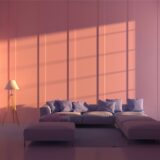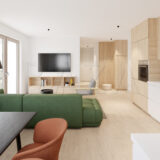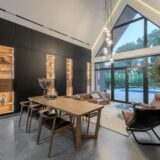In interior design, we often first think about colors, materials, and furniture layout, but the key element that connects all these components into a functional and aesthetic whole is lighting. Light is the means by which a space becomes usable – it is an inseparable part of architecture and interior design, helping to create atmosphere, highlight the character of a space, and influence mood.
Natural light has always been considered the most desirable form of illumination. Its quality and daily dynamics create a sense of vitality and natural rhythm. The design of spaces that allow more natural light to enter – through large windows, glass walls, or light lines – greatly affects how a space is experienced. Besides quantity, the direction of light is also important – morning and afternoon light create very different lighting effects. Architecture that enables correct orientation of spaces in relation to the sun is both energy-efficient and psychologically beneficial.
When natural light is no longer sufficient, artificial lighting takes on a key role. It must be more than just a substitute for daylight. Well-designed artificial lighting adapts to the function of the space while also building its identity. With proper planning of light sources, the space becomes both functional and visually balanced. Special attention must be given to understanding the color temperature of light: cool white tones feel more technical and stimulating, while warm yellowish tones wrap the space in a sense of comfort and relaxation. This distinction is essential in creating ambience, especially in rooms where intimacy or comfort is desired, such as living rooms or bedrooms.
Contemporary interiors are based on the concept of layered lighting, which means combining different lighting functions. General lighting provides basic visibility, often with diffuse ceiling lights. It is intended for safety and orientation, but by itself it often feels sterile. That’s why it is complemented by so-called task or functional lighting, directed at specific areas – a kitchen countertop, a desk, a bathroom mirror. The third level is accent lighting, which has no practical function but an aesthetic one – highlighting decoration, an architectural feature, or the texture of a material, thereby adding depth and character to the space. All three levels must work together in a thoughtful and coordinated way to create a balanced visual effect.
In contemporary design, light is not just present – it becomes a design language. Lighting fixtures are no longer merely technical elements, but aesthetic highlights. Their form, materials, light direction, and installation method offer opportunities for style expression. From minimalist recessed lights to bold pendant lamps in dining areas – each choice speaks about the space and its user. Lighting fixtures can thus either become focal points or blend completely into the architecture, becoming an almost invisible source of atmosphere.
Research has long confirmed that lighting directly affects our mood, concentration, and even sleep quality. That’s why modern design increasingly includes so-called “human centric lighting” – lighting that adapts to an individual’s natural biological rhythm. Such lighting simulates the movement of the sun throughout the day: in the morning, it is bright and cool to wake us up, while in the evening it becomes warmer and softer, promoting relaxation and preparation for rest. This is especially important in spaces where people spend a lot of time without contact with the outside world.
With the development of smart technology, lighting is becoming more adaptable every day. Smart homes allow the programming of lighting scenarios – for work, relaxation, dinner, or movie night – all controlled via mobile devices or voice commands. Light is thus no longer a static factor, but a responsive component of our daily life. In addition to comfort, such systems also enable energy efficiency, as lighting operates only when and where it is truly needed.
Lighting in a space is therefore not just a necessity – it is a creative tool with which the interior designer defines the rhythm, atmosphere, and identity of a space. A good interior without thoughtful lighting remains incomplete. Only through light do materials reveal their texture, colors gain their true tone, spatial proportions become clear, and the user experience becomes pleasant.
For more information or consultation, contact us: Tel: 00386-40-626-131; Email: tajnistvo@bazarealestate.com.






